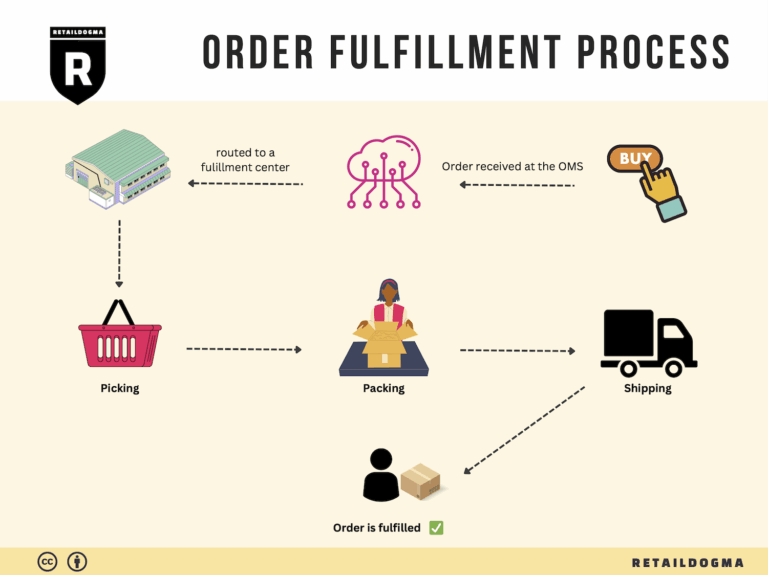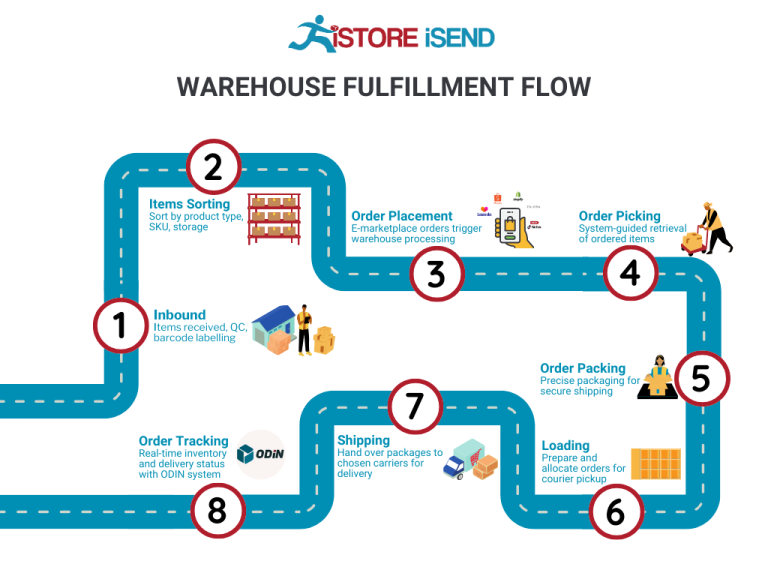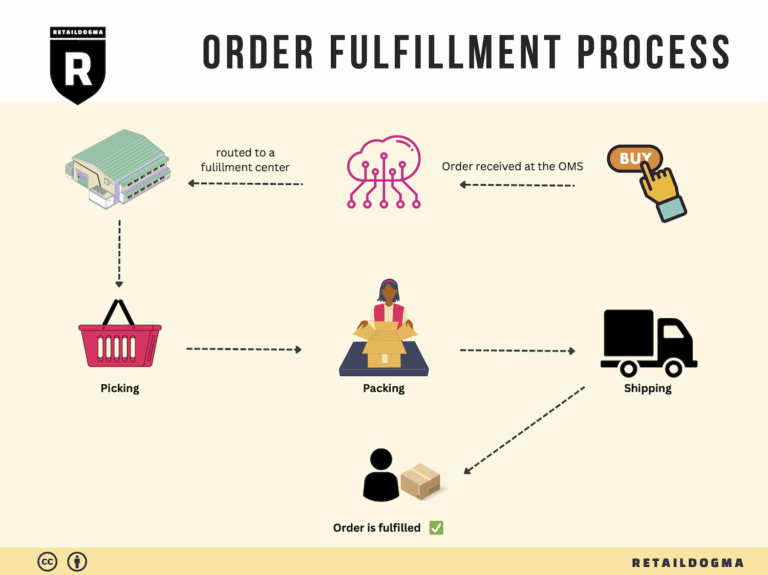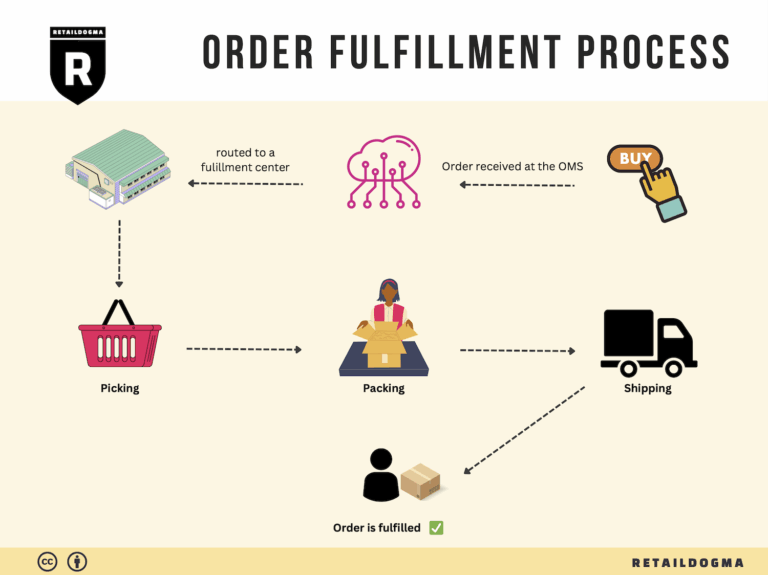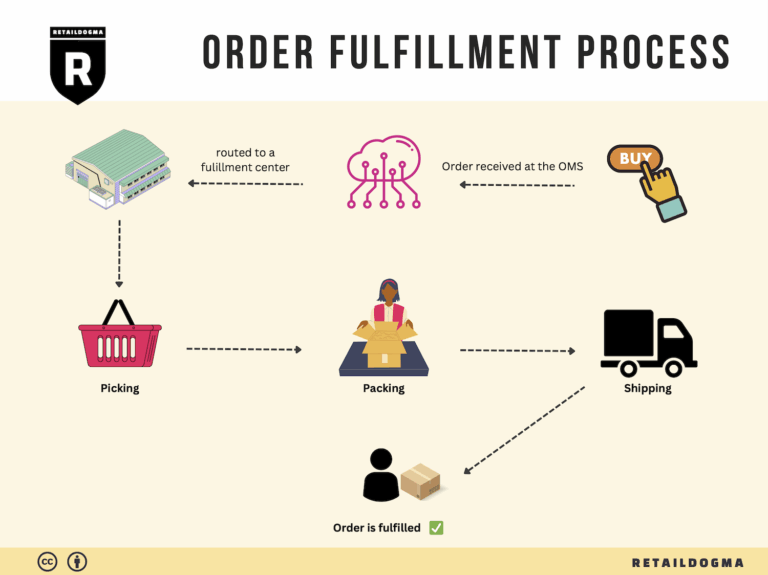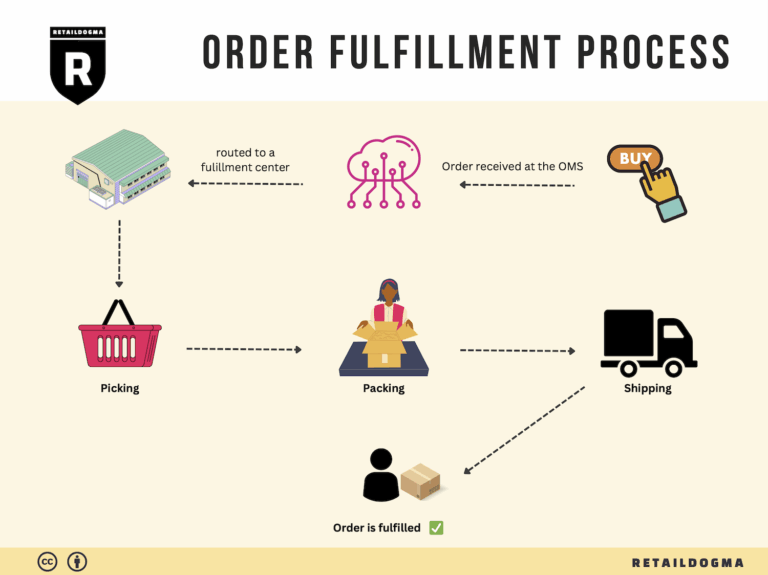What Is A Fulfillment Center? A Complete Guide (2025)
What is E-commerce Fulfillment? An Introduction for Growing Businesses
Understanding E-commerce Fulfillment
As an e-commerce business owner, you may find yourself facing a daunting challenge: managing the packing and shipping of orders while striving to grow your brand. This often leads to frustration and overwhelm, especially during peak seasons or after a successful marketing campaign. The process of fulfillment—the act of getting products from your warehouse to your customers—can quickly become a bottleneck that stifles growth and diminishes customer satisfaction.
E-commerce fulfillment encompasses all activities involved in processing and delivering an order to a customer. This includes inventory management, order processing, packing, shipping, and handling returns. For growing businesses, mastering this process is critical not just for operational efficiency but also for maintaining a positive customer experience. A seamless fulfillment strategy can be a key differentiator in a competitive market, helping you turn first-time buyers into loyal customers.
In this guide, we will explore various fulfillment models, including Third-Party Logistics (3PL) and Fulfilled by Amazon (FBA), to help you understand which option may best suit your business needs. We’ll delve into the core services offered by fulfillment partners, such as inventory storage, order processing, and shipping, while also discussing the importance of scalable solutions that can adapt to your business’s evolving demands.
Choosing the right fulfillment partner is paramount. We’ll provide insights into what to look for in a partner, from technology integrations to customer service quality. Additionally, we will cover pricing structures, helping you navigate the costs associated with different fulfillment options and ensuring that you can budget effectively as you scale.
The goal of this guide is to empower you—business owners, operations managers, and entrepreneurs—to make informed decisions about your logistics. By understanding the nuances of e-commerce fulfillment, you can streamline your operations, improve customer satisfaction, and ultimately drive growth. Whether you’re just starting out or looking to optimize your existing processes, this guide will provide the knowledge and tools you need to succeed in the complex world of e-commerce fulfillment.
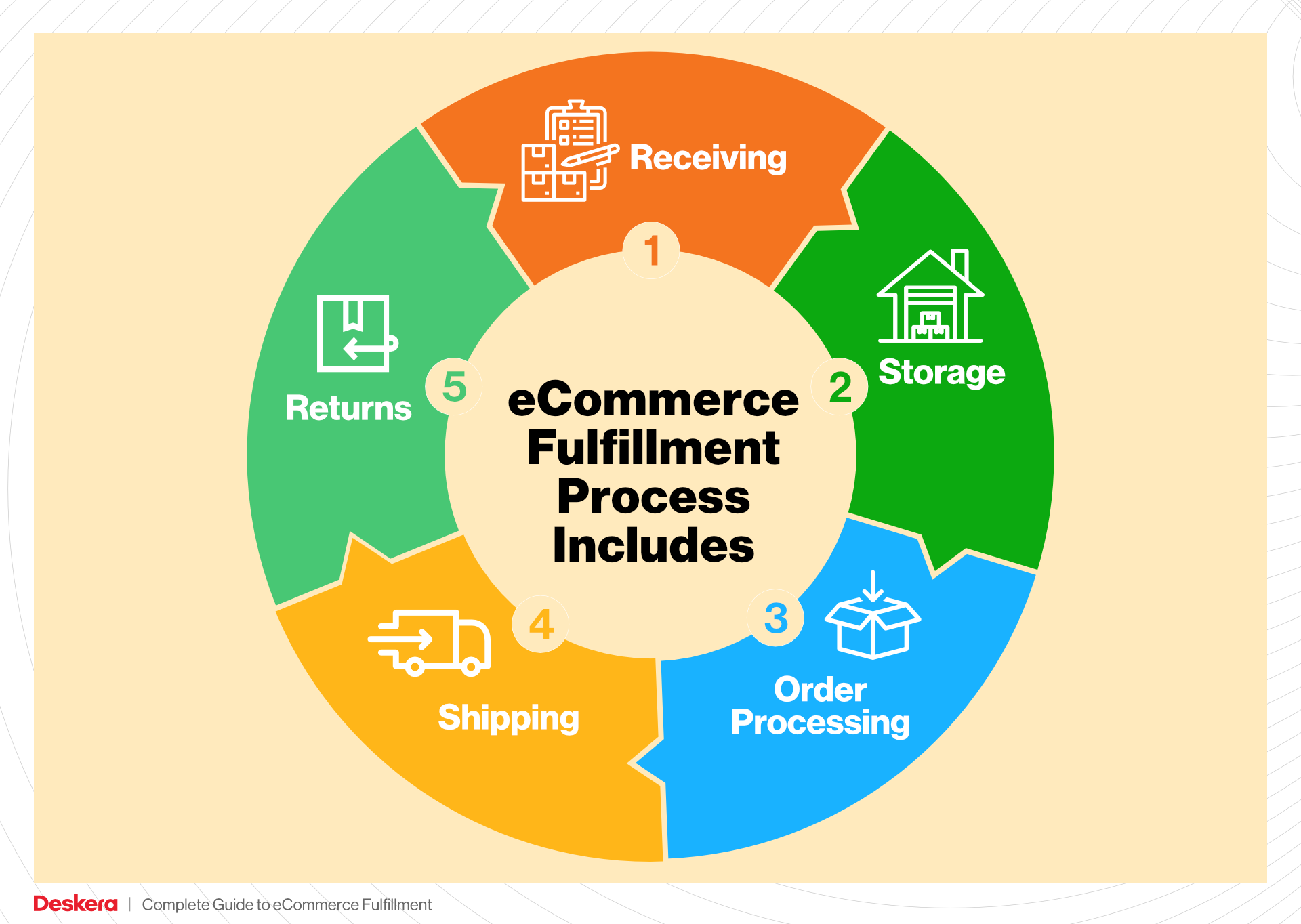
What You’ll Learn In This Guide
- What is E-commerce Fulfillment? An Introduction for Growing Businesses
- The Order Fulfillment Process: From ‘Buy’ Button to Customer’s Door
- Comparing Fulfillment Models: In-House vs. 3PL vs. Dropshipping
- A Deep Dive into Amazon FBA: Pros, Cons, and Who It’s For
- Core Services Offered by Fulfillment Centers
- How to Choose a Fulfillment Partner: A 6-Point Checklist
- Understanding Fulfillment Pricing: A Breakdown of Common Fees
- Frequently Asked Questions (FAQs) about Fulfillment
- Conclusion: Is Outsourcing Fulfillment the Right Move for Your Business?
- Important Disclaimer
The Order Fulfillment Process: From ‘Buy’ Button to Customer’s Door
1. Receiving Inventory
The order fulfillment process begins with receiving inventory, a critical step that sets the foundation for efficient operations. During this phase, products arrive at the warehouse from suppliers or manufacturers. Each item is carefully checked against the purchase order to ensure accuracy, with a focus on verifying quantities and product specifications.
A key term associated with this step is SKU (Stock Keeping Unit). SKUs are unique identifiers assigned to each product, allowing for easy tracking and management within the inventory system. Properly receiving inventory not only minimizes errors but also ensures that the warehouse is stocked with the correct products. This step is vital because any discrepancies here can lead to delays in fulfilling customer orders, ultimately impacting customer satisfaction.
2. Warehouse Storage
Once inventory has been received and verified, it is time for warehouse storage. This step involves organizing products in designated areas within the warehouse to optimize space and enhance retrieval efficiency. Effective storage solutions can include shelving, bins, and pallets, depending on the nature of the products.
The concept of FIFO (First In, First Out) is particularly important in this phase, especially for perishable or consumable goods. FIFO ensures that older stock is sold before newer stock, reducing the risk of obsolescence. Proper warehouse storage is essential for maintaining inventory accuracy and facilitating quick access during the order picking process. An organized storage system minimizes search time, enabling faster order fulfillment and enhancing overall operational efficiency.
3. Order Picking
The next step in the fulfillment process is order picking, where warehouse staff retrieve items based on customer orders. This is a critical stage as it directly influences the accuracy and speed of order fulfillment. When a customer places an order, a pick list is generated, outlining the items needed for that specific order.
Order picking can be conducted using various methods, such as single order picking, batch picking, or zone picking, depending on the volume and type of orders. The choice of picking method can significantly affect fulfillment speed. Accurate picking is vital; errors at this stage can lead to incorrect shipments, resulting in customer dissatisfaction and increased return rates. Efficient order picking is essential for maintaining high order accuracy and ensuring that customers receive their products as expected.
4. Order Packing
After items have been picked, they move to the order packing stage. This step involves carefully packing the products to ensure they arrive at the customer’s door in pristine condition. Proper packing not only protects the items during transit but also enhances the customer’s unboxing experience.
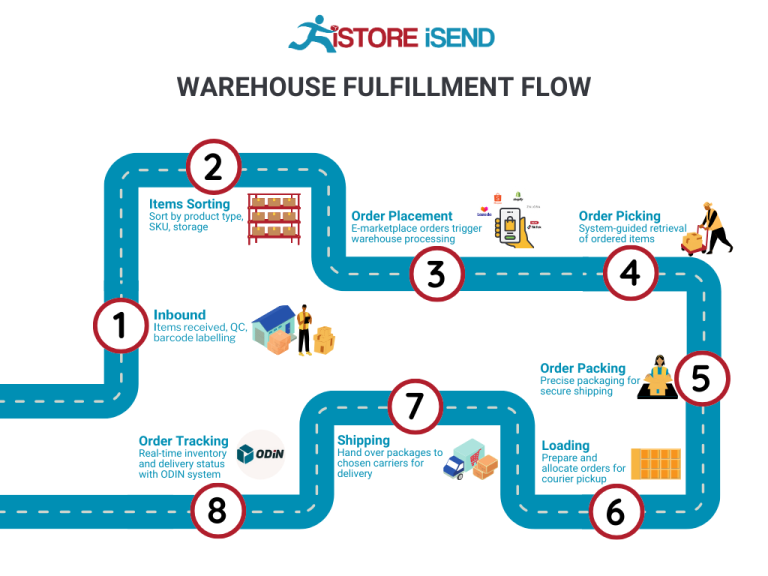
A key concept here is customizable packing. Many businesses opt for branded packaging or eco-friendly materials to align with their brand values and customer expectations. The packing process should also involve verifying that the correct items are included and that all necessary documentation, such as packing slips, is included in the shipment. Effective packing minimizes damages and returns, contributing to higher customer satisfaction and repeat business.
5. Shipping & Delivery
The final step in the order fulfillment process is shipping and delivery. Once orders are packed, they are prepared for shipment to customers. This stage involves selecting appropriate shipping carriers and methods based on factors such as cost, delivery speed, and service reliability.
A critical term related to this step is SLA (Service Level Agreement), which outlines the expected delivery times and performance metrics agreed upon with shipping partners. Adhering to SLAs is crucial for maintaining customer trust and satisfaction. Efficient shipping and delivery processes ensure that customers receive their orders promptly, which is increasingly important in today’s e-commerce landscape where speed can influence purchasing decisions.
In conclusion, the order fulfillment process encompasses several interrelated steps, each playing a vital role in delivering a seamless customer experience. By mastering each phase—from receiving inventory to shipping and delivery—e-commerce businesses can enhance operational efficiency, improve customer satisfaction, and ultimately drive growth.
Comparing Fulfillment Models: In-House vs. 3PL vs. Dropshipping
Fulfillment Model Comparison
| Model | Who Handles Inventory | Best For (Business Stage) | Key Advantage | Key Disadvantage |
|---|---|---|---|---|
| In-House Fulfillment | Your own team and facilities | Startups to established businesses | Complete control over processes and branding | High overhead costs and resource demands |
| Third-Party Logistics (3PL) | 3PL provider | Growing businesses | Scalability, expertise, and cost savings | Less control over inventory and processes |
| Dropshipping | Supplier | New and small businesses | Low upfront costs and minimal risk | Lower profit margins and reliance on suppliers’ reliability |
In-House Fulfillment
In-house fulfillment involves managing your own storage, inventory, and order processing within your own facilities. This model allows for complete control over every aspect of the fulfillment process—from inventory management to packaging and shipping. Businesses that choose this model typically have the necessary resources and infrastructure in place, which can include staff, warehousing space, and logistics management systems. In-house fulfillment is particularly advantageous for established businesses that prioritize brand consistency and customer experience, as it allows for tailored packaging and personalized service. However, it comes with significant overhead costs, including labor, storage, and equipment, and may not be sustainable for startups or businesses experiencing rapid growth. The demand for flexibility can also strain resources, especially during peak seasons or unexpected surges in demand.
Third-Party Logistics (3PL)
Third-party logistics (3PL) providers offer a comprehensive solution for businesses looking to streamline their fulfillment processes. By outsourcing storage, inventory management, and shipping to a 3PL, companies can focus on core business functions such as marketing and product development. This model is ideal for growing businesses that need to scale quickly without the burden of managing logistics themselves. A significant advantage of using a 3PL is their expertise in logistics management, which often includes access to advanced technology, discounted shipping rates, and a network of distribution centers that can enhance delivery speed and efficiency. However, one of the main drawbacks of this model is the reduced control over inventory and processes. Businesses must rely on the 3PL’s operational capabilities and communication, which can sometimes lead to discrepancies in service quality or fulfillment accuracy.
Dropshipping
Dropshipping is a fulfillment model where the retailer does not hold inventory but instead partners with suppliers who ship products directly to customers on behalf of the retailer. This model is particularly attractive for new and small businesses that want to minimize upfront investment and operational complexity. Since the retailer does not manage inventory, they can offer a wide range of products without the associated risks of unsold stock. Additionally, dropshipping reduces overhead costs, as there are no warehousing or shipping responsibilities. However, dropshipping comes with its own set of challenges. Profit margins are typically lower due to the reliance on suppliers, and the retailer has little control over product quality, shipping times, or inventory levels. This can lead to customer dissatisfaction if orders are delayed or if products do not meet expectations. Moreover, the business is heavily dependent on the reliability of suppliers, making it crucial to choose partners carefully.
Conclusion
Choosing the right fulfillment model is a critical decision for any e-commerce business. Each model has its unique advantages and disadvantages, making it essential for business owners to assess their specific needs, resources, and growth goals. In-house fulfillment offers control and brand consistency but at a higher cost and resource demand. Third-party logistics provide scalability and expertise, ideal for growing businesses, but with less control over operations. Dropshipping presents a low-risk entry point for new businesses but may result in lower profit margins and challenges related to supplier reliability. Ultimately, the decision should align with the business’s operational capabilities, customer expectations, and long-term growth strategy.
A Deep Dive into Amazon FBA: Pros, Cons, and Who It’s For
Understanding Fulfillment by Amazon (FBA)
Fulfillment by Amazon (FBA) is a service provided by Amazon that allows sellers to store their products in Amazon’s fulfillment centers. Amazon then takes care of storage, packaging, shipping, and customer service on behalf of the sellers. This service is designed to simplify the logistics of e-commerce, enabling businesses to scale efficiently without the burden of managing their own warehousing and shipping processes.
When a customer orders a product through an FBA seller, Amazon picks, packs, and ships the product directly to the customer. Additionally, Amazon handles returns and customer inquiries, providing a comprehensive fulfillment solution that can help sellers focus on other aspects of their business, such as marketing and product development.
How FBA Works
- Account Setup: Sellers create an Amazon seller account and register for FBA.
- Product Listing: Sellers list their products on Amazon and select which items they want to fulfill through FBA.
- Inventory Shipment: Sellers send their inventory to Amazon’s fulfillment centers, where it is stored until sold.
- Order Processing: When a customer places an order, Amazon’s system automatically processes it, selecting the nearest fulfillment center to reduce shipping times.
- Shipping and Handling: Amazon picks and packs the product, ships it to the customer, and provides tracking information.
- Customer Service and Returns: Amazon manages all customer service inquiries and handles product returns on behalf of the seller.
Pros of FBA
Prime Eligibility
One of the most significant advantages of using FBA is that it allows sellers to offer their products with Amazon Prime eligibility. This can lead to increased visibility and sales, as Prime members tend to favor products that qualify for free and fast shipping.
Customer Trust
Amazon is a trusted brand with a well-established reputation for customer service. By using FBA, sellers can leverage this trust, as customers often feel more secure purchasing from Amazon-backed listings. Positive experiences with FBA can lead to higher conversion rates and repeat purchases.
Multi-Channel Fulfillment
FBA isn’t limited to Amazon.com; it can also handle orders from other sales channels. Sellers can use FBA to fulfill orders from their own websites or other e-commerce platforms, streamlining their logistics and maintaining consistency in shipping and customer service.
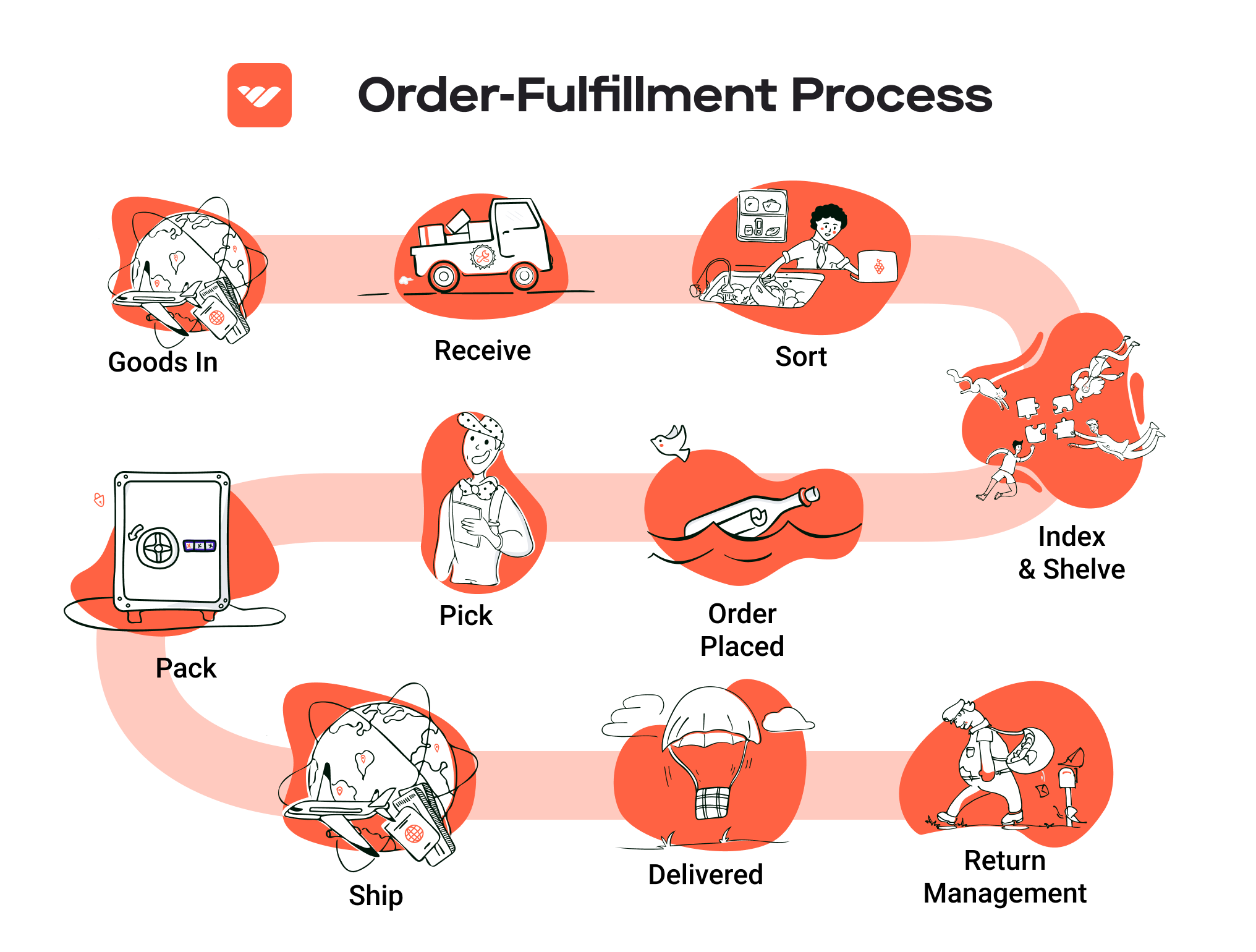
Scalability
FBA provides a scalable solution for businesses of all sizes. Whether you are a small startup or a large enterprise, FBA can accommodate fluctuations in demand, such as seasonal spikes or sudden viral trends. This flexibility allows businesses to grow without the need to invest heavily in logistics infrastructure.
Simplified Logistics
With FBA, sellers can offload the complexities of inventory management, order processing, and shipping logistics. This allows them to focus on product development and marketing strategies, improving overall business efficiency.
Cons of FBA
High Fees
While FBA offers many benefits, it comes with costs that can add up quickly. Amazon charges storage fees based on the amount of inventory stored in its warehouses and fulfillment fees for each unit sold. These fees can significantly impact profit margins, especially for low-cost items or products with slow turnover.
Strict Inventory Rules
FBA has stringent inventory management policies that sellers must adhere to. For instance, there are limits on how long products can be stored in Amazon’s warehouses before incurring long-term storage fees. Additionally, sellers must ensure their inventory is compliant with Amazon’s guidelines, which can be a challenge for new sellers unfamiliar with the platform.
Commingling Risks
When using FBA, sellers’ inventory may be commingled with other sellers’ inventory. This means that a seller’s product could be shipped to a customer without them knowing which specific unit was sent. While this can expedite shipping, it also poses risks related to quality control and potential negative impacts if another seller’s product is defective or damaged.
Limited Control Over Shipping
Once inventory is sent to Amazon, sellers have limited control over how their products are stored and shipped. This lack of control can be concerning for businesses that prioritize brand experience and packaging quality. Additionally, delays in Amazon’s fulfillment process can lead to unhappy customers.
Who is FBA Best For?
Fulfillment by Amazon is an excellent option for various types of sellers, particularly those who:
-
Are New to E-Commerce: New sellers can benefit from Amazon’s established infrastructure and customer trust, allowing them to focus on growing their business without the burden of logistics.
-
Sell High-Volume Products: Sellers with high sales volume or fast-moving consumer goods can leverage FBA to maximize their reach and minimize shipping times.
-
Prioritize Customer Experience: Businesses that want to offer a seamless shopping experience with fast shipping and reliable customer service will find FBA advantageous.
-
Have Limited Logistics Resources: For sellers lacking the resources to manage their own warehousing and shipping, FBA provides a scalable solution that minimizes overhead.
-
Utilize Multi-Channel Sales: Sellers who sell across multiple platforms can streamline their operations by using FBA to fulfill orders from various sales channels.
In conclusion, Fulfillment by Amazon offers a powerful solution for e-commerce businesses looking to simplify their logistics while leveraging Amazon’s extensive reach and customer trust. However, it is essential for sellers to carefully evaluate the associated costs and operational considerations to determine if FBA aligns with their business goals.
Core Services Offered by Fulfillment Centers
Inventory Management & Warehousing
Inventory management and warehousing are foundational services provided by fulfillment centers. This involves the systematic tracking and storage of products in a secure facility. Fulfillment centers utilize advanced Warehouse Management Systems (WMS) to monitor stock levels, manage reordering, and facilitate real-time visibility into inventory status.
Benefits:
1. Accuracy and Efficiency: With high inventory accuracy ratings (often exceeding 99%), businesses can trust that their stock levels are correctly monitored, reducing the risk of overstocking or stockouts. This accuracy translates into improved operational efficiency and better customer satisfaction.
-
Scalability: Fulfillment centers offer the flexibility to scale operations according to seasonal demands or sudden spikes in order volume. This is particularly advantageous for e-commerce businesses that experience fluctuating sales patterns, such as during holiday seasons or promotional events.
-
Cost Savings: By outsourcing warehousing, businesses can save on overhead costs associated with maintaining their own storage facilities. This includes rent, utilities, and labor costs. Fulfillment centers often provide competitive storage fees, allowing e-commerce businesses to allocate resources more effectively.
Pick and Pack Services
Pick and pack services involve the process of selecting items from inventory (picking) and preparing them for shipment (packing). Fulfillment centers employ trained staff and efficient systems to ensure that orders are processed quickly and accurately.
Benefits:
1. Speed of Fulfillment: Fast order processing is crucial in e-commerce, where customers expect quick delivery. Fulfillment centers can often ship orders within 1-2 days, enhancing customer satisfaction and encouraging repeat business.
-
Order Accuracy: High order accuracy is a hallmark of professional fulfillment services. This minimizes the chances of shipping errors, which can lead to returns and diminished customer trust. Accurate order fulfillment reinforces brand reliability.
-
Customization Options: Many fulfillment centers offer customizable packing options that reflect a brand’s identity. Whether it’s using eco-friendly materials or including branded inserts, businesses can enhance their customer’s unboxing experience, fostering brand loyalty.
Kitting and Assembly
Kitting and assembly refer to the process of bundling individual items together to create a single product or kit. This is particularly useful for businesses that sell products that are often purchased together, such as a skincare regimen or a DIY kit.
Benefits:
1. Streamlined Processes: By combining multiple products into a single kit, fulfillment centers simplify the picking and packing process. This can lead to faster processing times and reduced labor costs, as fewer individual items need to be handled during fulfillment.
-
Increased Sales Opportunities: Kitting can create unique offerings that may appeal to customers looking for complete solutions. This can lead to higher average order values, as customers are more likely to purchase bundled products rather than individual items.
-
Inventory Control: Kitting allows businesses to manage inventory more effectively by tracking the components of each kit. Fulfillment centers can ensure that all necessary items are in stock to meet demand, which enhances overall operational efficiency.
Returns Management (Reverse Logistics)
Returns management, or reverse logistics, is a critical service provided by fulfillment centers, particularly in the e-commerce sector where return rates can be significantly high. This service involves the handling of returned products, ensuring they are processed, restocked, or disposed of efficiently.
Benefits:
1. Improved Customer Experience: A smooth returns process is essential for maintaining customer satisfaction. Fulfillment centers streamline returns by offering easy return procedures and quick processing times, which can enhance customer loyalty and trust in the brand.
-
Cost Efficiency: By managing returns in-house, fulfillment centers can minimize costs associated with processing returns, including labor, shipping, and restocking fees. Efficient returns management can significantly reduce the financial impact of returned goods on a business.
-
Data Insights: Fulfillment centers can provide valuable data on return trends, helping businesses identify common issues with products or shipping. This information can be leveraged to improve product quality, customer service, and overall operational efficiency.
In summary, the core services offered by fulfillment centers—inventory management and warehousing, pick and pack services, kitting and assembly, and returns management—are designed to enhance the operational efficiency of e-commerce businesses. By leveraging these services, businesses can focus on growth and customer engagement while ensuring that their logistics and fulfillment processes run smoothly.
How to Choose a Fulfillment Partner: A 6-Point Checklist
Location & Warehouse Network
Importance: The location of a fulfillment center is crucial for efficient shipping and cost management. A strategically placed warehouse can significantly reduce shipping times and costs, enhancing customer satisfaction and potentially leading to repeat business.
Questions to Ask:
– Where are your warehouses located, and how does that impact shipping times to my customer base?
– What is your average shipping time to major markets?
– Do you have multiple warehouse locations to support different regions?
Technology & Integrations
Importance: In today’s e-commerce landscape, the right technology can streamline operations and provide real-time visibility into inventory and order status. A fulfillment partner should offer a robust Warehouse Management System (WMS) that integrates seamlessly with your e-commerce platform.
Questions to Ask:
– What technology platforms do you use for inventory management and order fulfillment?
– Can your systems integrate with my existing e-commerce platforms (e.g., Shopify, Amazon, WooCommerce)?
– How do you ensure data accuracy and security within your technology systems?
Specializations (e.g., cold storage, oversized items)
Importance: Different businesses have unique product needs, whether it’s temperature-sensitive items, oversized products, or specific packaging requirements. A partner that specializes in your product category can ensure compliance with industry standards and improve overall fulfillment accuracy.
Questions to Ask:
– Do you have experience handling my specific product type (e.g., perishables, fragile items, oversized products)?
– What special facilities or equipment do you have in place to handle these products?
– Are there any additional compliance requirements for my product category, and how do you address them?
Scalability & Capacity
Importance: As your business grows, your fulfillment partner must be able to scale operations accordingly. Look for a partner that can handle fluctuations in order volume, whether it’s seasonal spikes or rapid growth due to a marketing campaign or viral trends.
Questions to Ask:
– How do you manage peak seasons or sudden increases in order volume?
– What measures do you have in place to ensure consistent service quality during high-demand periods?
– Can your facilities accommodate my projected growth over the next few years?
Pricing and Contracts
Importance: Understanding the pricing structure and contract terms is essential for budgeting and financial planning. Look for transparency in pricing, including any hidden fees that may arise.
Questions to Ask:
– Can you provide a detailed breakdown of your pricing model, including storage, picking, packing, and shipping fees?
– Are there any long-term contracts or commitments required, and what is the process for terminating the partnership if needed?
– Do you offer volume discounts, and how do they apply to different service levels?
Customer Support & Reviews
Importance: A responsive and knowledgeable customer support team can make a significant difference in your fulfillment operations. Additionally, checking reviews and testimonials can provide insights into the partner’s reliability and service quality.
Questions to Ask:
– What kind of customer support can I expect (e.g., dedicated account manager, 24/7 support)?
– How do you handle issues or discrepancies in order fulfillment?
– Can you provide references or case studies from businesses similar to mine?
Conclusion
Choosing the right fulfillment partner is a critical decision that can impact your e-commerce business’s efficiency, customer satisfaction, and ultimately, your bottom line. By carefully evaluating potential partners against this checklist, you can make an informed choice that aligns with your business goals and operational needs. Prioritize partners who not only meet your requirements but also demonstrate a commitment to being a collaborative partner in your growth journey.
Understanding Fulfillment Pricing: A Breakdown of Common Fees
Initial Setup Fees
When partnering with a third-party logistics (3PL) provider, many businesses encounter initial setup fees. These fees cover the costs associated with onboarding your e-commerce business into the fulfillment center’s system. Typically, these fees may include:
- Account Creation: Establishing your account in their warehouse management system (WMS).
- Integration Costs: Connecting your e-commerce platform (like Shopify, WooCommerce, or Amazon) with the fulfillment provider’s system to streamline order processing.
- Training: Some providers offer training sessions on how to manage inventory and orders within their platform.
Initial setup fees can vary widely based on the complexity of your business needs and the technology employed by the fulfillment provider. Expect to pay anywhere from a few hundred to several thousand dollars depending on these factors.
Receiving Fees
Receiving fees are charged when your products arrive at the fulfillment center. These fees account for the labor and resources required to unload, inspect, and input your inventory into the warehouse system.
Typically, receiving fees may include:
- Unloading Costs: Charges for the labor involved in unloading shipments.
- Inspection Fees: Costs related to checking items for damage or discrepancies against purchase orders.
- Inventory Input: Fees for entering items into the WMS, ensuring they are properly tracked and accounted for.
Receiving fees are often calculated on a per-pallet or per-box basis, depending on the provider. It’s crucial to understand these fees, as they can add up, especially with frequent shipments.
Storage Fees (per pallet/bin)
Storage fees are charged for keeping your inventory in the fulfillment center. These fees can be structured in various ways, but they typically depend on the space your products occupy.
Common pricing structures include:
- Per Pallet Fee: Charged for each pallet your inventory occupies. This is common for larger items.
- Per Bin Fee: Used for smaller items stored in designated bins or shelves.
Storage fees can be calculated monthly or annually, and providers may charge differently based on the season. For example, during peak seasons like the holidays, storage fees may increase due to higher demand for space. To optimize costs, it’s wise to assess your inventory turnover rates and adjust your storage needs accordingly.
Pick & Pack Fees (per item/order)
Pick and pack fees are charged for the process of selecting items from inventory and packaging them for shipment. This is a critical area where fulfillment costs can accumulate, especially for e-commerce businesses with a high volume of orders.
Key components of pick and pack fees include:
- Picking Fee: A fee for retrieving items from the shelves. This is often charged per item or per order.
- Packing Fee: A fee for packaging the items securely for shipment, which may vary based on the type of packaging used (standard vs. custom).
Typically, providers charge a base fee plus a variable fee for each item picked or packed. Understanding this fee structure can help you gauge the overall cost-effectiveness of your fulfillment operations.
Shipping Fees
Shipping fees are the costs associated with delivering orders to your customers. These fees can be influenced by several factors, including:
- Shipping Method: The choice between standard, expedited, or overnight shipping will affect costs.
- Destination: Shipping to remote locations may incur higher fees.
- Weight and Dimensions: Carriers often charge based on the weight and size of packages, so optimizing packaging can help reduce costs.
Many fulfillment providers negotiate discounted shipping rates with carriers, which can be passed on to you. It’s essential to ask about these discounts when getting quotes. Additionally, understanding your customer demographics can help you choose the most efficient shipping methods and reduce costs.
Tips for Getting an Accurate Quote
To ensure you receive an accurate quote for fulfillment services, consider the following tips:
- Be Transparent About Your Needs: Clearly outline your expected order volume, product types, and any special requirements.
- Ask About All Fees: Request a breakdown of all potential fees, including those that may not be immediately obvious (like seasonal surcharges).
- Evaluate Contract Terms: Understand the contract terms, including any cancellation fees or long-term commitments.
- Negotiate: Don’t hesitate to negotiate fees, especially if you’re bringing a significant volume of business to the provider.
- Compare Multiple Providers: Obtain quotes from several fulfillment centers to compare not only pricing but also service levels and capabilities.
By following these guidelines, you can make informed decisions that align with your business growth strategies and budget constraints.
Frequently Asked Questions (FAQs) about Fulfillment
1. What is product fulfillment?
Product fulfillment refers to the complete process of receiving, processing, and delivering customer orders. This includes inventory management, order picking, packing, shipping, and handling returns. Effective fulfillment ensures that customers receive their orders accurately and on time, which is critical for maintaining customer satisfaction and loyalty.
2. What’s the difference between a warehouse and a fulfillment center?
A warehouse is primarily used for storage and inventory management, while a fulfillment center focuses on processing and delivering orders. Fulfillment centers are equipped with systems and processes to pick, pack, and ship products quickly and efficiently, often with a higher emphasis on order accuracy and speed compared to traditional warehouses.
3. What is a 3PL?
A Third-Party Logistics (3PL) provider is a company that offers outsourced logistics services, including warehousing, fulfillment, and transportation. Partnering with a 3PL allows businesses to leverage the provider’s expertise, technology, and infrastructure to streamline their supply chain operations and focus on core business activities.
4. How much do fulfillment services cost?
The cost of fulfillment services varies based on several factors, including order volume, types of products, storage space required, and shipping destinations. Pricing models may include per-order fees, storage fees, and shipping costs. It’s advisable to request quotes from multiple fulfillment providers to find a solution that fits your budget and needs.
5. How can fulfillment solutions help scale my e-commerce business?
Fulfillment solutions can help scale your e-commerce business by streamlining order processing, reducing shipping times, and improving inventory management. By outsourcing fulfillment, you can focus on marketing, product development, and customer engagement while ensuring that orders are fulfilled accurately and efficiently, even during peak seasons.
6. What types of products can be fulfilled?
Fulfillment centers typically handle a wide range of products, from consumables like supplements and beauty products to apparel and electronics. Many fulfillment providers can accommodate specific storage and handling requirements, such as temperature control for sensitive items, making them versatile for various industries.
7. How do I choose the right fulfillment partner?
When selecting a fulfillment partner, consider factors such as their experience, technology capabilities, order accuracy rates, shipping options, and customer service. It’s also beneficial to assess their ability to scale with your business, their location for shipping efficiency, and any additional services they offer, such as returns management or customized packaging.
8. What is the typical order processing time?
Typical order processing times can range from a few hours to a couple of days, depending on the fulfillment center’s efficiency and the volume of orders. Many fulfillment providers aim for same-day or next-day shipping to enhance customer satisfaction, especially for e-commerce businesses competing on speed.
9. How do fulfillment centers handle returns?
Fulfillment centers typically have a returns management process in place, which includes receiving returned items, inspecting their condition, restocking them if they are sellable, and updating inventory records. A streamlined returns process is crucial for maintaining customer trust and ensuring that returned items are handled efficiently.
10. Can I customize my packaging and branding with fulfillment services?
Yes, many fulfillment providers offer customizable packaging options that reflect your brand. This can include branded boxes, eco-friendly materials, and personalized packing slips or inserts. Customization helps enhance the unboxing experience for customers and reinforces brand identity, which can lead to increased customer loyalty.
Conclusion: Is Outsourcing Fulfillment the Right Move for Your Business?
The Case for Outsourcing Fulfillment
In the fast-paced world of e-commerce, outsourcing fulfillment can be a game-changing decision for your business. By partnering with a fulfillment service, you can save valuable time that can be redirected towards growing your brand. This allows you to focus on strategic initiatives like marketing and product development, rather than getting bogged down in the logistics of order processing and shipping.
Scalability is another significant advantage of using a fulfillment partner. As your business experiences fluctuations in demand—be it through seasonal spikes or viral trends—an experienced fulfillment provider can seamlessly scale operations to meet your needs. This flexibility ensures that you can handle increased order volumes without compromising speed or accuracy, maintaining customer satisfaction and loyalty.
Moreover, partnering with a fulfillment service brings a wealth of expertise to your operations. These providers specialize in logistics and inventory management, often utilizing advanced technology to optimize processes. Their knowledge of best practices can enhance your operational efficiency, reduce shipping costs, and improve order accuracy—key factors that contribute to customer retention and overall business growth.
However, it’s crucial to choose the right fulfillment partner. Look for a provider that aligns with your brand values and can adapt to your specific needs. Conducting a thorough audit of your current shipping process can help you identify gaps and determine if outsourcing fulfillment is the right next step for your business.
Take action today: evaluate your logistics operations and consider how a dedicated fulfillment partner could help streamline your processes and support your growth. Your business’s success may just depend on it.
Important Disclaimer
⚠️ Important Disclaimer
The information in this guide is for educational purposes. Fulfillment services, pricing, and platform features change frequently. Always conduct your own due diligence and consult with providers directly before making business decisions.

